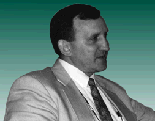
Decontaminating and Decommissioning DOE facilities
Tapping private-sector technologies
In February 1995, the
U.S. Department of Energy's
Morgantown Energy Technology Center in West Virginia was selected to be the lead organization for the decontamination and decommissioning focus area. METC's role is to implement the technical program for the focus
area. Initiatives met Robert Bedick, the product manager for environmental and waste management, and Paul Hart, the lead technical manager for implementing the D&D focus area, at METC on August 28. On August
30, Initiatives
spoke with Stephen Lien, the Office of Technology Development (EM-50) representative on the focus area team. Lien works at DOE headquarters to coordinate policy and strategy for the D&D focus area.
According to Paul Hart, "This focus area has the highest private-sector involvement of any of the five." In fact, 78 percent of the $42 million budget for the decontamination and decommissioning focus area is dedicated to the private sector ... [which includes] industry, universities, and non-profit organizations." Hart continued, "That is by design because there is a general awareness that solutions [to D&D problems] reside out there. We simply need to bring them into the complex, validate them, and foster their implementation."
Robert Bedick wanted to make clear, however, that "We don't intend to cut out the labs from research and development opportunities. If the labs have the best people and the best way of doing things, we want to draw on that expertise."
But the fact is, Hart said, "There are lots of radioactive facilities in the private sector belonging to the commercial nuclear power industry, research reactors at private companies, non-profit organizations, and universities," and they face problems similar to the D&D focus area.
These problems include 7,000 contaminated buildings in the weapons complex that require deactivation, 700 of which are currently planned for full decommissioning. Also, Hart explained, "There is a huge amount of contaminated metal [550,000 metric tons] and concrete [23 million cubic meters] in contaminated buildings that require disposition." Plus, the D&D focus area is looking for ways to reduce the high safety and health risks associated with working in these contaminated facilities.
Bedick and Hart agree that METC was selected to be the lead organization for the D&D focus area because of its successful track record of working with industries. METC's relationship with the Office of Technology Development began in 1990 when METC started managing industry solicitations for OTD.
D&D workshop
An initial step in getting industry input for the direction of the D&D focus area was a workshop held in July at METC. Bedick said, "Since one of the industries that may bring some solutions is the nuclear utility industry, we made an effort to include utilities and architectural and engineering firms and specialty D&D contractors that typically work with the utility industry."
 One of the main things Bedick got out of the workshop was that industry would like METC to help identify the DOE market for D&D technologies. He found that industry needs a clearer understanding of the market and more assurance of the profitability of developing D&D technologies. Another comment that kept being raised during the workshop, Bedick said, was "the need for better characterization and monitoring activities [because D&D] is so labor intensive and has a potentially high risk to workers." There also were comments about the need for personal protection equipment for workers.
One of the main things Bedick got out of the workshop was that industry would like METC to help identify the DOE market for D&D technologies. He found that industry needs a clearer understanding of the market and more assurance of the profitability of developing D&D technologies. Another comment that kept being raised during the workshop, Bedick said, was "the need for better characterization and monitoring activities [because D&D] is so labor intensive and has a potentially high risk to workers." There also were comments about the need for personal protection equipment for workers.
 "The really important thing [about the workshop]," in Hart's opinion, "was that METC and the DOE complex were able to sit down with industry and exchange information. We are sincere that we want to involve industry because we have similar needs and they have potential solutions that can be quickly implemented in the DOE complex."
"The really important thing [about the workshop]," in Hart's opinion, "was that METC and the DOE complex were able to sit down with industry and exchange information. We are sincere that we want to involve industry because we have similar needs and they have potential solutions that can be quickly implemented in the DOE complex."
As a result of the workshop and other preliminary work of the focus area team, Bedick said, "We have consolidated a lot of the projects and started to focus on some large-scale demonstrations working cooperatively mainly with EM-40 [the Office of Environmental Restoration], but also EM-30 [the Office of Waste Management] and EM-60 [the Office of Nuclear Material and Facilities Stabilization]. We're finding out the scope of what EM-40 needs to clean up. We want to bring in some new technologies to do it better, at lower cost to reduce environmental risk and worker exposure risks, or do something we currently can't do."
In July, METC issued an informal call for proposals from DOE operations offices for the D&D focus area to work cooperatively on large-scale D&D demonstrations. Proposals are currently under review.
D&D technologies
Hart and Bedick explained a few technologies currently being worked on by the focus area. Solid uranium deposits inside process equipment and piping is a major problem at DOE sites. Hart said, "We have completed a pilot-scale demo in Oak Ridge [of a technology that] converts solid uranium deposits into a gaseous uranium form so it can be removed without having to dismantle the equipment."
He continued, "Gloveboxes contaminated with plutonium is also a huge problem across the DOE complex. We have a demonstration under way at Savannah River of an industrial decontamination technology." A glovebox is a controlled enclosure for handling plutonium that has two rubber gloves that extend inside. At one time, workers actually put their hands in the gloves and manipulated things inside the box. Now that is done with remote manipulation. A chemical decontamination process removes the plutonium from a glovebox in a form that can be converted to glass for final disposal.
Bedick added, "We don't actually know how clean the gloveboxes have to be, which is why we're doing the demo. We're hoping we will be able to dispose of them as a low-level or non-radioactive waste."
According to Hart, "About a third of the resources for DOE's robotics program is devoted to the D&D focus area." Robotics technology is especially important because it removes workers from hazardous situations. Robots can also be used for surveillance and maintenance of the 7,000 buildings on the list for deactivation.
If you have a technology that might benefit the D&D focus area, call Paul Hart at (304) 285-4358. He said, "I'd be happy to get those calls."
Headquarters perspective
Like DOE's other four focus areas (radioactive tank waste remediation, mixed waste treatment, landfill stabilization, and contaminant plume containment), policy and strategy concerns of the D&D focus area are managed by a team including representatives from the Office of Environmental Management in DOE headquarters (EM-30, EM-40, EM-50, and EM-60). Stephen Lien represents the Office of Technology Development on the team.
 Currently, standards exist for the lowest acceptable level for materials to be contaminated on the surface before they can be released for reuse. One of the long-term strategies for the D&D focus area is to facilitate the adoption of release standards for materials that are contaminated throughout. "If we don't have release standards [for bulk contaminated materials]," Lien explains, "we cannot release that material or use technology for the most beneficial type of disposal option: reuse of the materials."
Currently, standards exist for the lowest acceptable level for materials to be contaminated on the surface before they can be released for reuse. One of the long-term strategies for the D&D focus area is to facilitate the adoption of release standards for materials that are contaminated throughout. "If we don't have release standards [for bulk contaminated materials]," Lien explains, "we cannot release that material or use technology for the most beneficial type of disposal option: reuse of the materials."
Another problem facing the D&D focus area is that its activities can easily be delayed when Congress has a funding shortage. Lien collectively refers to the facilities needing decontamination as a "sleeping giant." He warns, "You can keep the giant snoozing for only so long. One day, this giant will wake up," and when it does, he hopes to have technologies ready to start a massive D&D job.
The five Ds of D&D
There are really more than two Ds in the D&D focus area. If you're confused, here are some simplified definitions of how DOE uses the terms.
Deactivation is a process by which a facility is taken out of service. It includes stabilizing the facility so surveillance and monitoring can be done at a reduced level of effort. All other Ds follow deactivation. There are 7,000 buildings in the weapons complex that require deactivation.
Decontamination is the removal of radioactive material from equipment or structures in a facility that has been deactivated.
Dismantlement involves breaking equipment and structures into pieces and removing them from the facility. Dismantlement occurs after decontamination and prior to decommissioning.
Disposition refers to getting rid of pieces of equipment or structures after decontamination and dismantlement. The material is disposed of as waste or recycled. DOE has 550,000 metric tons of metal and 23 million cubic meters of concrete in contaminated buildings that require disposition.
Decommissioning is the result after the other Ds are completed. There are 1,200 contaminated buildings in the weapons complex that require decommissioning.





 One of the main things Bedick got out of the workshop was that industry would like METC to help identify the DOE market for D&D technologies. He found that industry needs a clearer understanding of the market and more assurance of the profitability of developing D&D technologies. Another comment that kept being raised during the workshop, Bedick said, was "the need for better characterization and monitoring activities [because D&D] is so labor intensive and has a potentially high risk to workers." There also were comments about the need for personal protection equipment for workers.
One of the main things Bedick got out of the workshop was that industry would like METC to help identify the DOE market for D&D technologies. He found that industry needs a clearer understanding of the market and more assurance of the profitability of developing D&D technologies. Another comment that kept being raised during the workshop, Bedick said, was "the need for better characterization and monitoring activities [because D&D] is so labor intensive and has a potentially high risk to workers." There also were comments about the need for personal protection equipment for workers.


